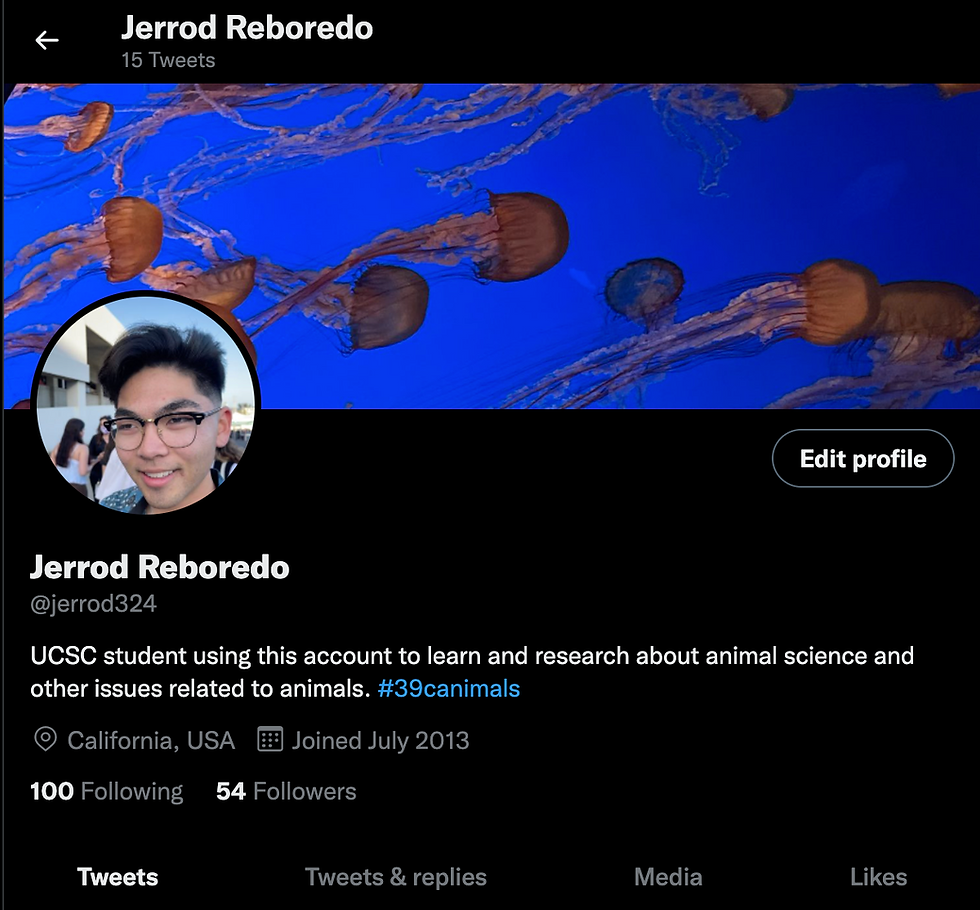Week 2 Blog: Social Medias Capabilities in Research
- jrebored
- Apr 7, 2022
- 3 min read
Updated: Apr 13, 2022
Using Twitter has all been very new to me, as my main form of social media is Instagram and Snapchat. But I have found Twitter very convenient and informative in searching for reachers, articles, videos, organizations, and other animal science related topics. Some topics that I found on Twitter that I found interesting enough to retweet was about intelligence and communication in dogs, cognition in birds, and companionship in goats which all could potentially be topics that I will choose for further research. I choose to retweet these topics because of its connection to the Time articles that we read and also the documentary that we watched which covered the same themes as the articles and videos that I retweeted on Twitter. From analyzing these new articles and videos on Twitter, I have learned about more cross species interaction other than the ones presented in the source material from this class. I think one of the most interesting things that I have learned is how other species will readily use "tools" that we as humans use, such as my example with cognition of birds. In the tweet I retweeted, a corvid is videoed snowboarding down a hill. I ponder if this new learned skill is instinctually due to the environment that he is in or if he could have potentially picked up on this behavior from watching humans. Some Parts of Twitter that I don't really feel comfortable with is not knowing if the information that I am retweeting is valid information as anyone can post something on the internet which could be fake.

End of Week 2 Blog:
From the reading in weeks 1-2 it has changed my perspective in particular the ethics of animals and seeing them more as individuals and not just as a pet. For context I have two pet hamsters at home, named Jolene and Hannah. I would play with them and notice that these two would be very particular about who they would let hold or play with them. Usually, it's only my mom, my girlfriend, or me; whenever any of my friends tried to hold them or would be in the same room they would get very aggressive and territorial. I’m realizing that even though hamsters are solitary creatures, “the need for close contact can be powerful” (47-48). They admire the space that they have alone, but also gain that sense of comfort as King says, which defies the rules of the animal kingdom.
Another issue that I have gained a new perspective on is the importance of animal ethics. From doing research on Twitter, I saw a quote saying, “people are less likely to care about small animals” and before doing research in this class, I wouldn’t agree with this statement because I have hamsters. However, now, I can see how us humans show little care for small animals. For example, when I was looking at Mark Moffets research on ants, he pointed out how complex yet conjoined their colonies are. The system he describes is similar to our organ system, “Its body spreads over space in pieces that give it a multitude of eyes and brains with which to glean nutrients, energy, and information” (31). This makes me wonder if people really care when they destroy the role of this system anytime they step on and kill an ant. I would think not, because most of the time people are not even conscious even to know that they had just stepped on an ant. This brings me to how my perspective has in fact changed. I previously would not think about other animals' emotions. But now, knowing that some animals can consciously feel pain and or hurt as described by Singer then those animals have no defensible claim to be killed or eaten.

Safina’s prologue is about the notion that all life is connected. The author gives an example about how dolphins swim alongside their babies and mothers. This communal behavior shows the close - social relationship that this particular species has. The biologist Randell Wells, similarly observed bottlenose dolphins and noticed this pattern and deduced that, “Dolphin moms will form circles around their young to protect them from predators” (44). More generally, the prologue sets to provide context to the questions that the author is pondering. These questions include; “What do animals do and why they do it” (2) based on the travels and observations over her life.




I think your sharing on Twitter is very interesting and your experience with animals also interests me. I have to say that Twitter is a very good software for us to learn more about animals.
thank you for sharing your thoughts! I did not use the Tweet before at all, but I think this is a very convenient platform to gain some knowledge quickly.